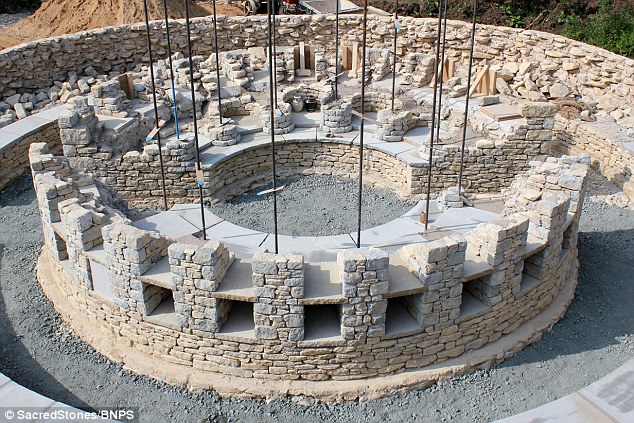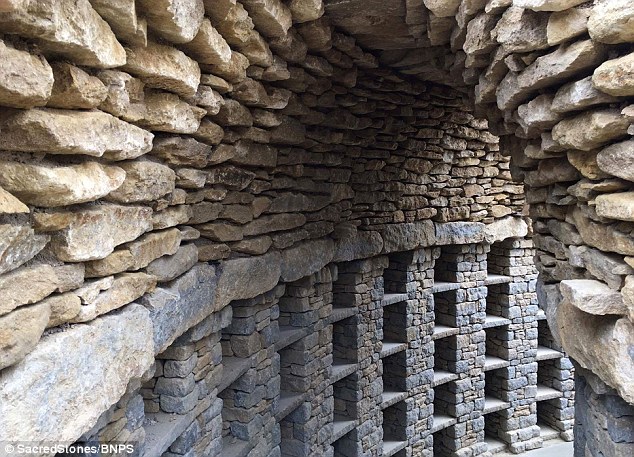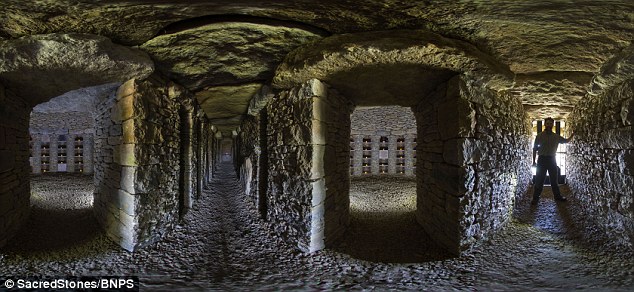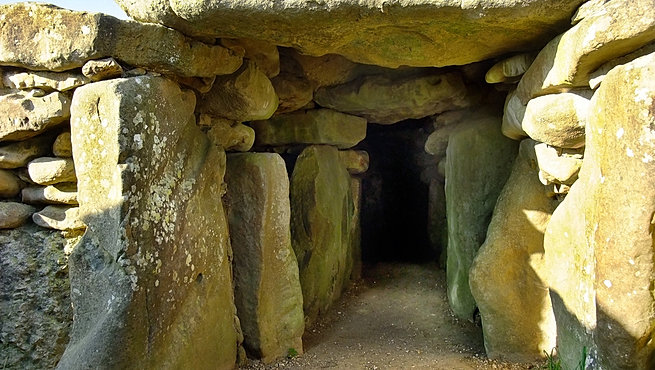Prehistoric stone tombs used to store the ashes of loved ones are being built in Britain for the first time in thousands of years.
The ancient resting places could help to tackle the problem of a lack of burial space.
Until now, Neolithic earth mounds built over the dead, known as long barrows, had not been used since around 2,000 BC.
However, a company is about to open a barrow near St Neots, Cambridgeshire, after the idea proved surprisingly popular among people looking for a final resting place.
Return of the burial mound: Neolithic stone tombs could be used in the UK to store ashes for the first time in 4,000 years
The earth mounds, built over the dead, have not been used since 2,000BC
The prehistoric stone tombs were used to store the ashes of loved ones
A Cambridgeshire company is bringing back the ancient tombs after the idea proved surprisingly popular with people seeking a final resting place
By Libby Plummer For Mailonline
25 October 2016
Prehistoric stone tombs used to store the ashes of loved ones are being built in Britain for the first time in thousands of years.
The ancient resting places could help to tackle the problem of a lack of burial space.
Until now, Neolithic earth mounds built over the dead, known as long barrows, had not been used since around 2,000 BC.

The limestone frame covered in soil and grass was entirely handmade by a team of four stonemasons using traditional techniques over the course of five months
However, a company is about to open a barrow near St Neots, Cambridgeshire, after the idea proved surprisingly popular among people looking for a final resting place.
The limestone frame covered in soil and grass was entirely handmade by a team of four stonemasons using traditional techniques over the course of five months.
The project took more than 3,500 hours and in excess of 300 tons of Northamptonshire limestone to complete.
The end result is a large dune of earth with a burial space within.

The earth-covered barrow contains 400 niches for families to reserve at £2,000 ($2,442) to £5,000 ($6,106) a plot

Plots, or niches, line the walls and a central passageway bisects the circular chamber, which is illuminated by candles
Plots, or niches, line the walls and a central passageway bisects the circular chamber, which is illuminated by candles.
The limestone walls support a striking beehive-shaped corbelled roof above and on the outside. The insulating earth roof ensures that everything underneath is kept dry.
Stone seating has been built in the woodland surrounding the barrow.

Work starting on the new St Neots barrow in Cambridgeshire. In 2014, stonemason Tim Daw built the first barrow on British soil in 5,500 years

An image shows the base of the new tomb starting to take shape in St Neots, Cambridgeshire

The base of the new long barrow is being built up from the ground out of limestone

The limestone frame covered in soil and grass was entirely handmade by a team of four stonemasons using traditional techniques over the course of five months

Toby Angel of Sacred Stones is behind the scheme to build new long barrows
Sacred Stones, the Bedfordshire company behind the project, was inspired by associate and stonemason Tim Daw who built the first barrow on British soil in 5,500 years in 2014.
While Tim's was a labour of love, Sacred Stones views the project as the beginning of a successful business.
The firm will be selling 400 niches for between £1,950 ($2,381) and £7,000 ($8,549).
The niches come in three different sizes according to the number of urns it can fit.
A single niche measures 180 cubic inches, a double 210 and a large, with enough room for up to five urns, measures 350 cubic inches.
Toby Angel, managing director of the company, said: 'Our objective is that people will use these structures to celebrate life.
'What has struck me most is just how meaningful our barrows have become for people.
'They spend hours in there talking or simply admiring the craftsmanship. It's a beautiful place to lay someone to rest.
'Inside it's very calm and peaceful. The only light comes from the entrance or people can light candles.'

The barrow is being built in St Neots, Cambridgeshire


The earth-covered barrow contains 400 niches for families to reserve at £2,000 ($2,443) to £5000 ($6,103) a plot

Toby Angel of Sacred Stones (pictured left) is behind the new building boom. Neolithic barrows are being built again as burial mounds for modern Britons
He added: 'There is no common trend among the people who are interested. We have a variety of different ages and religions.
'People love the fact that our barrows are secular but they are free to practice whatever faith they like.
'My local vicar came to visit and absolutely loved it. She completely understands what we are doing.'
Mr Angel says the emergence of barrows could also provide an answer to the lack of burial space in the UK, which experts say could soon develop into a crisis.


Plots, or niches, line the walls and a central passageway bisects the circular chamber, which is illuminated by candles. The firm will be selling 400 niches for between £1,950 ($2,381) and £7,000($8,549)

In 2014 in Wiltshire, farmer Tim Daw built the first long barrow on British soil for 5,500 years, allowing families to place urns containing the ashes of their loved ones within it from £400 per niche
A recent survey revealed around 50 per cent of local authorities fear they have 20 years or less before they run out of room.
The cost of a niche is similar or in many cases even cheaper than a traditional burial, which on average runs to £3,800 ($4,641).
Mr Daw said the purchase becomes even more cost-efficient when you consider each niche has at least enough room for two urns.
Willow Row is located in a secluded area of countryside surrounded by woodland and fields, visitors have to walk about a third of a mile from the nearest car park.
Sacred Stones has had interest in its business from all over the world and is currently planning barrows in eight other British counties.
WHAT ARE LONG BARROWS?

Construction on West Kennet long barrow in Wiltshire was started around 3,600BC, about 400 years before construction started on Stonehenge
Long barrows were Neolithic burial chambers.
Earth mounds were built over the stone structures, which acted as collective tombs.
The ancient burial chambers have not been widely used in Britain since around 2,000 BC.

West Kennet long barrow
Read more: Return of the burial mound: Neolithic stone tombs could be used in the UK to store ashes for the first time in 4,000 years | Daily Mail Online
Follow us: @MailOnline on Twitter | DailyMail on Facebook
The ancient resting places could help to tackle the problem of a lack of burial space.
Until now, Neolithic earth mounds built over the dead, known as long barrows, had not been used since around 2,000 BC.
However, a company is about to open a barrow near St Neots, Cambridgeshire, after the idea proved surprisingly popular among people looking for a final resting place.
Return of the burial mound: Neolithic stone tombs could be used in the UK to store ashes for the first time in 4,000 years
The earth mounds, built over the dead, have not been used since 2,000BC
The prehistoric stone tombs were used to store the ashes of loved ones
A Cambridgeshire company is bringing back the ancient tombs after the idea proved surprisingly popular with people seeking a final resting place
By Libby Plummer For Mailonline
25 October 2016
Prehistoric stone tombs used to store the ashes of loved ones are being built in Britain for the first time in thousands of years.
The ancient resting places could help to tackle the problem of a lack of burial space.
Until now, Neolithic earth mounds built over the dead, known as long barrows, had not been used since around 2,000 BC.

The limestone frame covered in soil and grass was entirely handmade by a team of four stonemasons using traditional techniques over the course of five months
However, a company is about to open a barrow near St Neots, Cambridgeshire, after the idea proved surprisingly popular among people looking for a final resting place.
The limestone frame covered in soil and grass was entirely handmade by a team of four stonemasons using traditional techniques over the course of five months.
The project took more than 3,500 hours and in excess of 300 tons of Northamptonshire limestone to complete.
The end result is a large dune of earth with a burial space within.

The earth-covered barrow contains 400 niches for families to reserve at £2,000 ($2,442) to £5,000 ($6,106) a plot

Plots, or niches, line the walls and a central passageway bisects the circular chamber, which is illuminated by candles
Plots, or niches, line the walls and a central passageway bisects the circular chamber, which is illuminated by candles.
The limestone walls support a striking beehive-shaped corbelled roof above and on the outside. The insulating earth roof ensures that everything underneath is kept dry.
Stone seating has been built in the woodland surrounding the barrow.

Work starting on the new St Neots barrow in Cambridgeshire. In 2014, stonemason Tim Daw built the first barrow on British soil in 5,500 years

An image shows the base of the new tomb starting to take shape in St Neots, Cambridgeshire

The base of the new long barrow is being built up from the ground out of limestone

The limestone frame covered in soil and grass was entirely handmade by a team of four stonemasons using traditional techniques over the course of five months

Toby Angel of Sacred Stones is behind the scheme to build new long barrows
Sacred Stones, the Bedfordshire company behind the project, was inspired by associate and stonemason Tim Daw who built the first barrow on British soil in 5,500 years in 2014.
While Tim's was a labour of love, Sacred Stones views the project as the beginning of a successful business.
The firm will be selling 400 niches for between £1,950 ($2,381) and £7,000 ($8,549).
The niches come in three different sizes according to the number of urns it can fit.
A single niche measures 180 cubic inches, a double 210 and a large, with enough room for up to five urns, measures 350 cubic inches.
Toby Angel, managing director of the company, said: 'Our objective is that people will use these structures to celebrate life.
'What has struck me most is just how meaningful our barrows have become for people.
'They spend hours in there talking or simply admiring the craftsmanship. It's a beautiful place to lay someone to rest.
'Inside it's very calm and peaceful. The only light comes from the entrance or people can light candles.'

The barrow is being built in St Neots, Cambridgeshire


The earth-covered barrow contains 400 niches for families to reserve at £2,000 ($2,443) to £5000 ($6,103) a plot

Toby Angel of Sacred Stones (pictured left) is behind the new building boom. Neolithic barrows are being built again as burial mounds for modern Britons
He added: 'There is no common trend among the people who are interested. We have a variety of different ages and religions.
'People love the fact that our barrows are secular but they are free to practice whatever faith they like.
'My local vicar came to visit and absolutely loved it. She completely understands what we are doing.'
Mr Angel says the emergence of barrows could also provide an answer to the lack of burial space in the UK, which experts say could soon develop into a crisis.


Plots, or niches, line the walls and a central passageway bisects the circular chamber, which is illuminated by candles. The firm will be selling 400 niches for between £1,950 ($2,381) and £7,000($8,549)

In 2014 in Wiltshire, farmer Tim Daw built the first long barrow on British soil for 5,500 years, allowing families to place urns containing the ashes of their loved ones within it from £400 per niche
A recent survey revealed around 50 per cent of local authorities fear they have 20 years or less before they run out of room.
The cost of a niche is similar or in many cases even cheaper than a traditional burial, which on average runs to £3,800 ($4,641).
Mr Daw said the purchase becomes even more cost-efficient when you consider each niche has at least enough room for two urns.
Willow Row is located in a secluded area of countryside surrounded by woodland and fields, visitors have to walk about a third of a mile from the nearest car park.
Sacred Stones has had interest in its business from all over the world and is currently planning barrows in eight other British counties.
WHAT ARE LONG BARROWS?

Construction on West Kennet long barrow in Wiltshire was started around 3,600BC, about 400 years before construction started on Stonehenge
Long barrows were Neolithic burial chambers.
Earth mounds were built over the stone structures, which acted as collective tombs.
The ancient burial chambers have not been widely used in Britain since around 2,000 BC.
West Kennet long barrow
Read more: Return of the burial mound: Neolithic stone tombs could be used in the UK to store ashes for the first time in 4,000 years | Daily Mail Online
Follow us: @MailOnline on Twitter | DailyMail on Facebook
Last edited:



